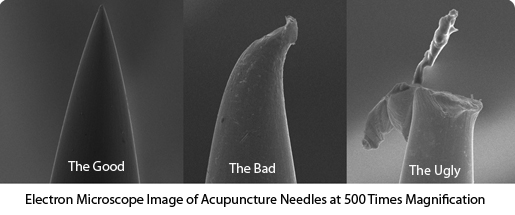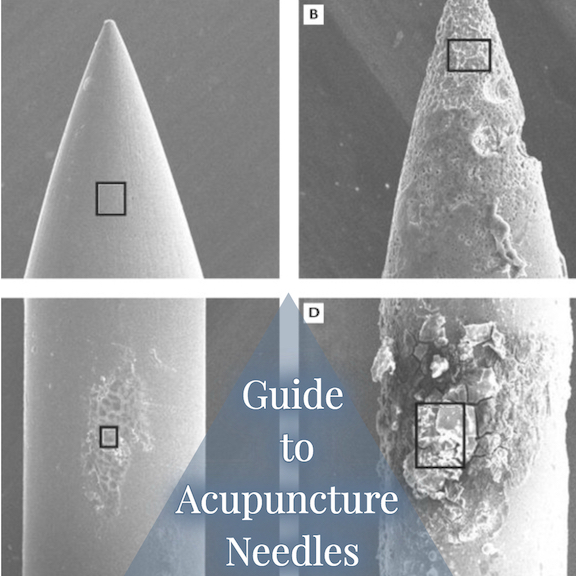Finding the Best Acupuncture Needles
You may be looking into what acupuncture needles to carry in your practice or maybe you’re looking to update the needles you carry, but can’t seem to find a straight answer on which acupuncture needles are best.
- Who do you believe?
- Which acupuncture needle brand is best?
- Plastic or copper handle?
- Why is this brand cheaper than that brand?
- Which brand will give a good enough experience to bring patients back and make them feel safe?
While your schooling may have given you a clue on types of needles, and answers to all these questions, there is not a lot out there to point an acupuncturist in the right direction on the safest and best needles to use for treatments. In fact, what most acupuncturists stumble upon are advertisements, all claiming to have the best needle at the best price. The fact is that there are many components that should be considered when choosing the right needles to carry.
Are All Acupuncture Needles Created Equal?
That would be a resounding “no”! Of course, the number one thing acupuncturists and patients alike are concerned with most is safety. We want to make sure we’re going by the book and at the same time making our patients feel at ease and comfortable, especially those that are doing acupuncture for the first time. The most common needle is a filiform needle made of stainless steel.
It’s important to do your research before you go with a brand of needle because:
- The stainless steel can come in many sub-varieties that may be of low-quality.
- There are also some irregularities in more popular brands as well.
Acupuncture Needle Safety: Sterilization
All acupuncture needles must meet the requirement of being sterile in their packaging. A recent study looked at the traditional method of sterilization, manual cleaning and thermal disinfection. The researchers found that it reduced the needle stick injuries to zero and raised patient satisfaction to 98%. This is only one type of sterilization and it is important to know when purchasing needles. Effective sterilization is essential for the safe treatment of patients. While general sterilization is a requirement, the quality control for sterilization and making of the actual needle is not the same amongst all brands, and the low-quality brand needles may have damaged and/or off-center tips. These types of needles may also contain a high amount of dead bacteria on the needle shaft only visible through a microscope and not to the naked eye. This will increase patient discomfort, pain, possible bleeding, and possible infection especially those with sensitive skin.
There are several factors that need to be taken into account when doing your research:
- Both the type and quality of steel used
- How the needles are sharpened
- Sterilization methods
- Which packaging facility was used and the cleanliness of it
- How needles are handled in the packaging facility
- Quality control standards for the brand at each level of manufacturing
- Possible lubricants being used
In addition to the quality of needle, it is also important to look at the type of services you will be providing and make a sound decision with that information. There is also the issue of whether it is better to use a copper handle or plastic handle. In 2014, there was a study done to address this question in regards to the needles buckling with each handle type, and how that effected patient safety. This was done using a dynamic mechanical analysis machine which is used to measure the physical properties of solids and behavior of polymers. The machine can also be programmed to measure force, stress, strain, frequency, and temperature.
Results show:
- Acupuncture needles with the copper handle were more apt to buckle than a needle with a plastic handle.
- The buckling force of plastic handles is 46.7% higher than those with copper handles in needles size .25mmx30mm and 30.8% higher in needles size .25mmx60mm.
- It states “replacing a copper coil handle with a plastic stick handle could save about 100 tons of copper wires and 20 million meters of medical grade stainless steel wire a year worldwide.”
Essentially, this study concludes that replacing the copper coil handle with a plastic stick handle would reduce needle buckling, and improve patient comfort and safety. Picking the right needle is becoming difficult. As acupuncture gains traction and popularity among consumers, this increases the demand of acupuncturists requiring needles to perform their services. Thus, more and more manufacturers spring to market to provide needles. Choosing a high-quality acupuncture needle from a reputable manufacturer is worth it for patient comfort and safety, but also to shine a positive light on acupuncture to the western world of medicine. The bottom line is, like with most things, you get what you pay for.
What’s Under the Microscope?
Acupuncture needles are amongst the thinnest around, meaning, any issues most of the time are not visible to the naked eye. As it was said previously, seeing these images shows us more than ever to perform our due diligence when choosing acupuncture needles. In this photo of acupuncture needles, you can clearly see the difference:

- “Good” is how a good-quality needle should look before insertion. This is what you want in a acupuncture needle.
- “Bad” represents what a needle can look like even in some popular brands depending on the manufacturing facility. They can have off-center tips which can potentially cause issues or pain during insertion.
- “Ugly” is the real eye-opener. This is presenting a needle of poor quality that has bacteria and potential steel fragments from not being sharpened properly which would then be inserted into the patient. This presents a massive problem for the safety of your patient being that it can cause pain, bleeding, or infection.
This next photo represents what a needle looks like before and after electroacupuncture.

A recent study took a look at the corrosion of the needle after stimulation and surface exams were looked at immediately after the session. The controls for the study were single use silicone coated stainless steel needles that were taken out from their original packaging and used for the experiment. An ES-160 acupunctoscope was used to deliver stimulation and an oscilloscope was used to record the waveforms and electric currents. As shown in the image, the corrosion to the needle was severe but they found no significant changes in the actual shape of the needle tip.
The Real Question: How Much Will This Cost Me?
First, it is important to look at what type of practice you have. If you are a high-volume practice then it may be beneficial to purchase in bulk needles that come 10 per pack with one guide and come in boxes of 1000, getting more bang for your buck. There are also packages available that come individually wrapped, each with their own guide, which can also be a preference for some acupuncture providers.
These brands are what other acupuncturists are currently using and/or prefer to use. ACE is not sponsored by any of the below brands, and advises all acupuncturists to learn about any new needle brands and/or manufacturers they may to use.
Seirin
This brand is probably the most popular on the market at the moment. Called the “painless” needle, it is of high-quality with a rounded guide tube and different color plastic handles indicating the gauge. There are three main types currently offered:
G-Type:
A longer needle that is ideal for sports medicine. You’re looking at anywhere between $14-$20 for a box of 100 for this type.
J-Type & D-Type:
A standard acupuncture needle with color coded handles. Needles synonymous with gentle, painless, and stress free. You’re looking at close to the same for these needles being anywhere from around $13-$20 for a box of 100 for these types
DBC
Another very popular brand on the market that are still high quality, but at a little lower price point. There are two main types:
Spring Pack
These stainless steel needles that can come in a box of 1000, with 10 needles per pack with one insertion tube. For the bulk box you’re looking at anywhere from $20-$28. These also come in boxes of 100 which are individually wrapped needles with tubes, and they will run you anywhere from $4.50-$13 depending on the gauge.
Nano Tech
These are the newest, re-engineered needles for this brand made for ease and accuracy with a painless experience. These come in bulk packs of 500 with 5 needles and one guide tube per package. These will run you around $25.
Tai-Chi
These needles have been around for quite some time and are Chinese style acupuncture needles that have silver plated spiral wound handles. The needles are individually wrapped each with their own guide tube. There are 2 main types
Standard Tai Chi needles
these fit the description above and are usually sold in boxes of 100 and will run you anywhere from $4-$11 depending on the gauge and metal type.
Gold-Plated
These needles also fit the same description as above the only difference being that they are 24k gold plated and will run you anywhere from $11-$14 per box of 100.
Peace
These seem to be a newer brand that is gaining popularity. They have what appears to be one type thus far featuring a coil handle and traditional Chinese loop on top made of stainless steel. They are individually packaged, each needle with their own guide tube. These will run you about $4 for a box of 100 and about $15 for a box of 500.
At the end of the day, do what is best for you, your practice, and your patients. There is so much out there to choose from and look into. The acupuncture needle is at the essence of our work – make sure it is worth it!

